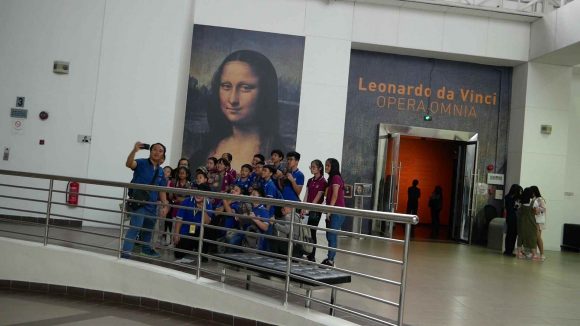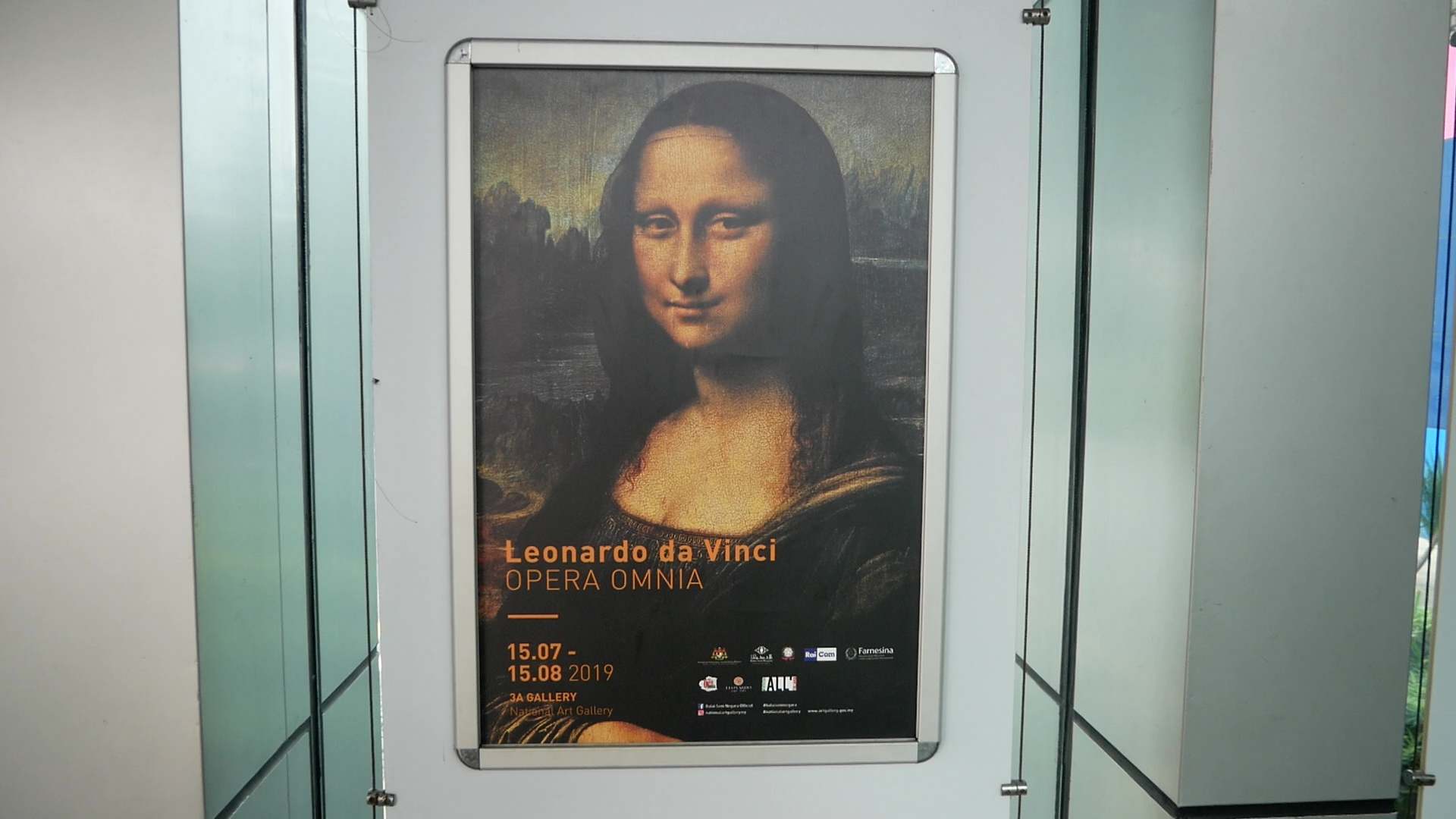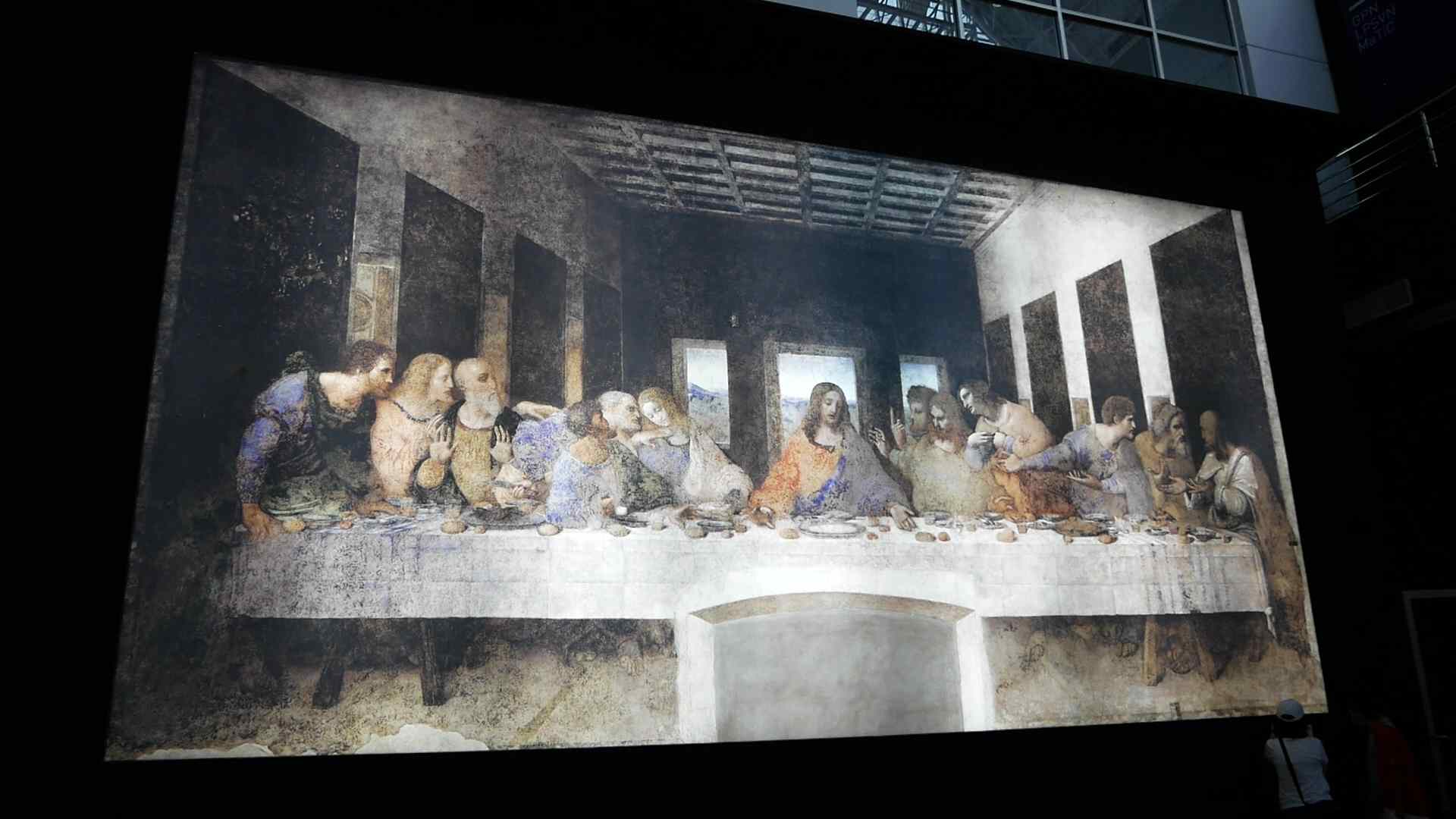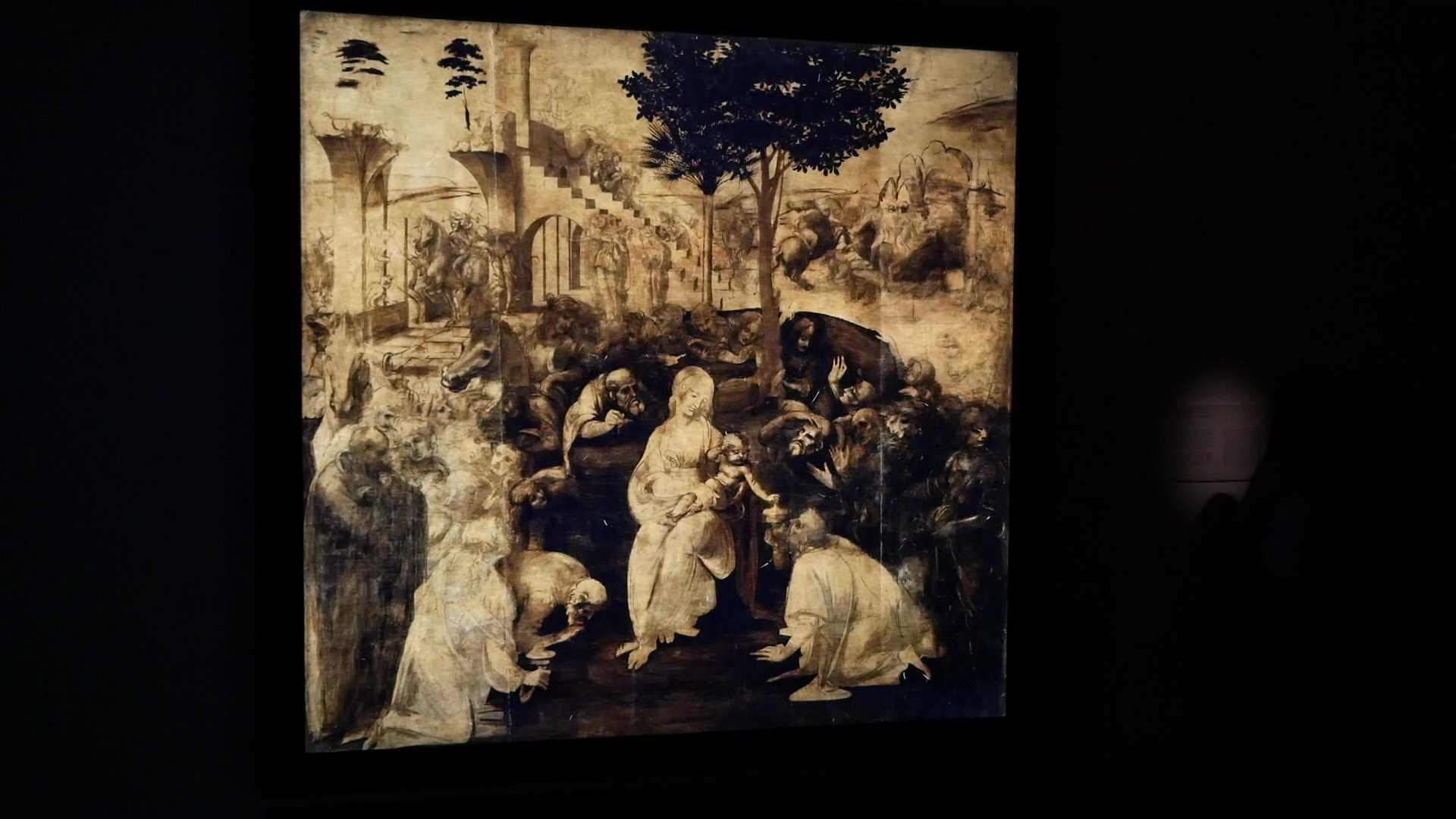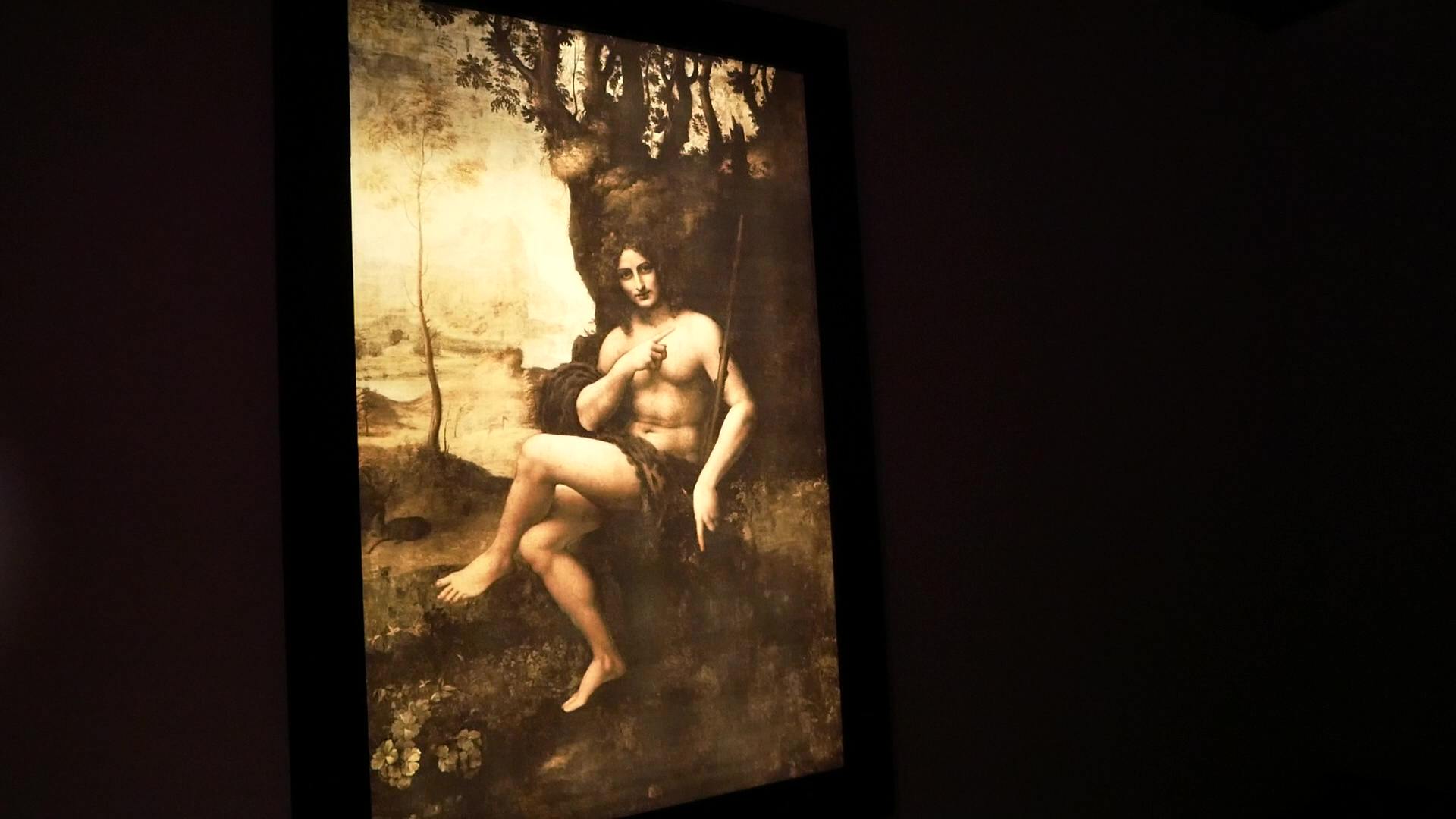JOURNAL: Leonardo da Vinci Exhibit at the National Art Gallery in Kuala Lumpur
Saturday, August 10, 2019
6:00 a.m. Room 4, Natalia Guest House
Kuala Lumpur, Malaysia
Yesterday, I went to the National Art Gallery to see an exhibit called Leonardo da Vinci OPERA OMNIA. The exhibit is running here from July 15 to August 15, and then it moves on to Bangkok and then Yangon. The exhibit was put on by the Italian government to mark the 500th anniversary of the death of Leonardo da Vinci. He was born in 1452 and died in 1519, exactly 500 years ago.
Leonardo is generally considered one of the geniuses of the Renaissance. In fact, he was practically the prototypical Renaissance Man with wide-ranging interests in multiple fields of study including human anatomy, weapons and engineering, chemistry, carpentry, flight, botany, art, sculpture, cartography, and many more. However, I think it’s fair to say that he is best-remembered and most famous for his paintings. His Mona Lisa is widely considered the greatest portrait ever painted. And his The Last Supper has been reproduced more often than any other religious artwork in history. All told, however, less than 20 paintings remain today that are generally attributed to him. Of those, I believe only 17 are definitely known to have been painted by Leonardo himself. Those 17 paintings – the originals – are currently held at different museums and galleries across eight countries. But this exhibit – the OPERA OMNIA – brings all 17 together in one place in the form of sophisticated digital reproductions.
As I learned at the exhibit, the organizers created special aluminum cages containing a high-tech array of adjustable LEDs. Transparent copies of the 17 original paintings were placed over these cages and back-lit by the LEDs to create near-perfect reproductions. According to the organizers, standing in front of these reproductions creates exactly the same range of emotions as standing in front of the originals. And the LEDs can be controlled to adjust for the lighting conditions in any of the museums or art spaces that this exhibition will find itself in. The LEDs can be controlled for brightness and for coolness and warmth depending on the light present in any museum.
I’d been to the National Art Gallery once before, and I even shot a video of that experience. The website for the National Art Gallery brags that the gallery is easily reached by public transportation, but if that is true, I never uncovered the public transportation in question. I took the monorail to Titiwangsa Station, and then I embarked on the long and meandering detour on foot required to get across a series of major highways that blocked my path. When I left from the gallery that first time, however, I discovered a much easier route that took me across Tun Razak on a pedestrian bridge and then down a couple of busy side streets to the Chow Kit monorail station. This route still demanded something of an effort, but it was easier than my approach. And yesterday, I followed that route to get there.
This route is easier, but it does entail over a kilometer of walking, and as I walked, I talked on video about what I knew of Leonardo and his life. I knew he was born in Italy in 1452 during the Renaissance. I knew that Leonardo was not really his last name. In fact, Vinci was the name of the small town in the Tuscan region of Italy, not far from Florence, where Leonardo was born. So, Leonardo da Vinci roughly translates as Leonardo of the town of Vinci. It is like calling me Douglas da Sarnia.
Leonardo’s talent in artistic fields was recognized at an early age, and at the age of 14, he was apprenticed to Andrea del Verrocchio, a popular artist of the day. Thus began a long life in the arts serving many powerful patrons, such as the Duke of Milan and the King of France. I learned a lot about Leonardo as I prepared for this exhibit. He was prolific in many fields, but he also often abandoned projects and never completed them. That was a pattern in his life. That pattern extended to his paintings, and even some of the 17 paintings that are considered masterworks were never completed. I believe even the Mona Lisa is considered unfinished even though Leonardo worked on it for four years.
Leonardo also never published in any field. He studied flight, for example, and filled notebooks with thoughts and drawings and studies of birds and bird wings. Yet, he never brought his ideas together in an organized fashion for publication. He did the same with his ideas for technological inventions. In his notebooks there were drawings for tanks, helicopters, and even machine guns. Most of the things he drew were not functional. They were not even possible to create at the time due to limitations of technology and materials. This, however, is seen as evidence of his genius because he was thinking far ahead of his time. Perhaps he was the first extreme example of thinking outside the box.
And this idea – the idea of Leonardo being ahead of his time – captures the general feeling I had about him after visiting this exhibit. People go on and on about the genius of Leonardo, but I kind of want to pump the brakes on that a bit. It’s actually hard for me to see real genius there. It sounds great that he invented a tank. But when you see the drawings of this tank, it’s really just a wooden box with wheels. And it appears to be quite impractical. The same can be said for his helicopter and the machine gun and lots of other things. And other marks of his genius – such as his use of maps and mapping – seem like little more than common sense today. When I see the sketches in his notebooks, I don’t see a whole lot more than the drawings one might see in the notebooks of any moderately intelligent high schooler today.
But that’s the key to understanding Leonardo. He isn’t living today. He was living more than 500 years ago when everything he was thinking about was brand new. To truly understand what he was doing and what he was thinking about, you have to see him in the context of when he lived. And then you can appreciate the unique qualities of his mind. It’s one thing to doodle a helicopter in your notebook today. But to do so in the fifteenth century is something else altogether.
I have to say that the actual paintings that I saw in the exhibit struck me in the same way. I understand that it takes a very special talent to paint at all. I cannot draw a circle. I cannot take a pencil and reproduce any object in the universe on paper. My brain simply does not work that way. So I am in awe of anyone who can sketch anything. I can see objects in my mind. I can think of a person and see their face. But it would be impossible to then recreate that face in any medium – drawing, painting, sculpting, etc. I couldn’t do it in a million years. It isn’t a question of practicing. It is a question of simply not having the part of a brain necessary to do it at all.
But that being said, there are lots of people all the time who do have the ability to recreate what they see in artistic form. I don’t know the numbers but I’m sure there are many millions of people around the world today who can sit down and paint a portrait that looks like the Mona Lisa. So, I have a fair bit of trouble getting super-excited about the genius of Da Vanci the artist when I just wander around a (very) dark room and look at 17 of his paintings. I don’t see why they are any better than any other paintings that I could find in galleries all across Kuala Lumpur right now. Basically, what’s the big deal?
I appreciate the talent required to paint The Last Supper. I don’t have that talent. It seems like magic to me. But I don’t see why that painting is considered a masterwork of genius worth preserving for 500 years while the hundreds of thousands of paintings done in the same period of time by other people are considered less accomplished. Perhaps, as with his inventions, you have to consider the time in which he worked and put them in context to truly understand them. And I don’t have the appreciation of the era or the knowledge of art to truly understand them. And I have to believe that most people going to this exhibit are in the same boat. We have all been told our entire lives by experts that Leonardo was a genius and the Mona Lisa is the greatest painting ever, and who are we to argue? So we flock to the Leonardo da Vinci exhibit and wait our turn to stand in front of the Mona Lisa in a darkened room and try to see what all the fuss is about.
More memorable for me, in fact, were the exhibits of modern art and installation pieces that I found on the first and second floors below the Leonardo da Vinci exhibit. Those, I could truly appreciate and enjoy. Leonardo’s paintings represented an era and a society that has nothing to do with me and that I don’t understand at all. The modern works, however, are from this time, comment on aspects of this society, and I could relate to them much better. As I said in the video that I made, if I had the chance to put a piece of art from the museum into my house – any piece at all – I would choose any piece from the modern art exhibit over any painting of Leonardo. Why would I want the Mona Lisa hanging in my living room? It means nothing to me. I’d much rather have the giant moon covered in slum housing and cob webs that I saw on the first floor. THAT I could relate to.
In fact, my biggest takeaway from the Da Vinci exhibit was the technology required to produce the exhibit in the first place. I watched a short documentary on the aluminum cages and the LEDs and all the technology to create these perfect reproductions. That made more of an impression on me than any of the paintings themselves. Perhaps that makes me a caveman and a person who can’t appreciate art. And that’s probably true. I’m not a visual person.
And as an experience, simply getting into the art gallery was more memorable than the contents of the Da Vinci exhibit. I showed up with my own carefully crafted collection of technology. I had my Panasonic G85 with its fancy Rode Wireless Go mounted on my equally fancy Suriu tripod. And I had a vast collection of memory cards, batteries, filters, and other accessories for my Panasonic and for my GoPro all carefully packed away inside my knapsack. But when I got to the door, I was immediately told that my tripod was not allowed inside. I could take a camera, and I could take pictures with that camera, but I was not allowed to use a tripod or even a selfie stick of any kind, and I was not allowed to shoot video. More than that, I was not allowed to bring in my knapsack. A security guard escorted me to a separate room where I was given a key to a locker. I had to then spend a frantic few minutes trying to grab what I needed from my knapsack and stuff it all in my pockets. I tried to do this quickly and without any fuss because I didn’t want to give anyone the impression that I was trying to get away with anything – which, to b truthful, I was. I fully intended to shoot video, and to do that, I needed all those batteries and memory cards. And I also wanted my GoPro as a backup to the Panasonic. So all the gear I was stuffing into my pockets was clearly more gear than a guy needs if he was just going to take a picture or two.
By the time I was done, I had to really tighten my belt because my pockets were so full that my pants were being dragged off my hips. Luckily, I didn’t also try to bring in a bottle of water because that, too, was not allowed. A table beside the entrance was covered in a couple hundred water bottles that had been lifted from people coming to the exhibit.
I generally like to follow the rules, but I didn’t feel bad about breaking the “no video” rule. My sense was that this rule was meant to restrict actual film crews from TV stations and that sort of thing. These professionals had to get permission in order to shoot video. And I understood that. I’m sure over the years, the museum organizers had had experience with crews showing up with tripods and lights and boom mics and this caused a lot of inconvenience for regular visitors. So they like to control and monitor people coming to shoot video. But someone like me – shooting five seconds of video of the Mona Lisa with a DSLR before moving on – isn’t going to cause a problem. In fact, the many, many people taking pictures with their smartphones caused more problems. I swear that half the people at this exhibit thought they were on a scavenger hunt. They quite literally ran from one painting to the next and snapped a photo of each until they had collected a photograph of every single painting in the exhibit. I saw people doing this who did not pause for even a second in front of each painting to look at it. They raised their phone, took a picture, and then ran to the next painting. They did this 17 times and then left. I guess they were now going to go home and look at the pictures of the paintings on their phone or on their computer.
The one problem for me was that even though I was able to shoot video inside the exhibit quite easily, I did feel constrained. So I didn’t hold up my camera and aim it at myself and provide any kind of narration. That would have been a dead giveaway that I was committing the cardinal sin of shooting video. So I was not able to vlog my actual experience of the exhibit. I shot some video of some of the paintings and I shot some video of some of the visitors to the museum, and that is about it. In fact, the exhibit rooms themselves were so dark that you couldn’t really see much other than the paintings. And I could barely see those or the information placards beside them. I understand that they were trying to recreate the somber and respectful lighting of a classic museum gallery, but, come on. A bit of light would have been nice. I felt like I was in a haunted house at times.
Just to complete my story of the day, I should mention that I woke up to a huge shock. It might have been my fault. I was distracted because I was shooting random bits of video of how I usually start my day. And so I was actually taking video of the stages now required to turn on my computer. And I forgot that my power bar was turned off, so the battery on my computer died and the computer shut down. But when I plugged in the power and pressed the button to turn on the computer again, something went wrong – something horrible. Instead of booting up as usual, it began loading a brand new copy of Windows. The message on the screen read “Preparing Windows”, and I had the sickening feeling that it was loading Windows for the very first time.
And that’s exactly what ended up happening. When it was finally done, I was faced with an unfamiliar and brand new and fresh (though very old) copy of Windows. And everything else was gone. It was like my computer had been wiped clean fresh from the factory. I had a panic attack when this happened. I had just finished editing and exporting a full hour-long YouTube video. It represented two days of work. And it appeared to be gone. And all the original video files were gone. All the programs were gone. My Google account was gone. The thought of how much work I would have to do just to go back to normal crushed me. It was not a good way to start the day.
Things worked out okay, though, because I did what we always do in these situations. I just shut off the computer and restarted it. And to my relief, it booted normally, and it loaded my regular copy of Windows with all my accounts and programs back in place. I have no idea what happened for the computer to load the old and original version of Windows, but it appears to have been temporary.

